
The Joy of Photography
Photography has become a much more familiar art with the spread of digital cameras and cell phones with built-in cameras. An increasing number of people now think of photography as a handy means of expression and a routine part of their daily lives.
The Digitization of Photography
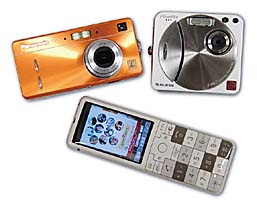
Not so long ago, the standard procedure in photography was to first buy film, take photos, have that film developed at a camera shop or a convenience-store-provided service, and receive the developed photographs along with a set of negatives. Today, it is becoming more common to take photos on a digital camera, save the images on a computer, and print out only the selected shots using a home printer. The camera shops that were once a fixture of every town are starting to disappear, and photographs themselves are seen less as a medium captured on film than as data files to be stored on a computer.
According to the Cabinet Office’s Research Regarding the Spread of Leading Durable Consumer Goods (as of end of March 2007), 58.9 percent of Japan’s 47.8 million households own a digital camera. Seventy-one percent of households own a computer, which is a necessity when using a digital camera.
Prices for digital cameras in Japan range from 30,000 to 50,000 yen. Considering that it costs about 1,500-2,000 yen to purchase and develop one roll of film, the price of a digital camera is not so expensive. New automatic image stabilization, focus, and face-recognition features make it possible for anyone to take photographs quite skillfully.
Digital cameras have changed the way pictures are taken and ways they are enjoyed thereafter. In the past, one had to purchase film, have it developed without knowing how the photographs would come out, all with great loss of time and money. With a digital camera, the quality of the picture can be checked on the spot and retaken if necessary. Photographs can also be selected for printing, allowing people to take many photographs without spending much time or money. Digital photography also encourages picture-taking not just on special occasions but of anything of interest in daily life, as a method of documenting life almost like a diary.
Photographs taken on digital cameras can be easily processed using a computer, so they can be used to make original postcards or create one-of-a-kind photo albums. Now the average person has control over the entire photography process, including printing. Digital cameras have accomplished something tremendous by allowing people who weren't familiar with photography to really enjoy taking pictures.
Taking Photos by Cell Phone
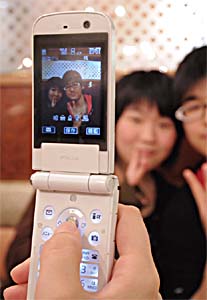
In Japan, cell phones are used by peoples of all ages, from children to the elderly. More than 90 percent of high school students have cell phones. Most models these days have a camera feature, making “taking photos” one of the prime uses of cell phones among high school students, along with calling, sending e-mail, checking the time and setting alarms, browsing the web, and listening to music.
Footage of accidents and news events, which would usually have been shot by experts with cameras or video cameras on the scene, are now also taken by ordinary people with cell phones and sometimes shown on news programs. Also, people are beginning to take pictures not just of their vacations and other special occasions, but as a way of saving information they want to make note of, or showing something from their daily lives, such as by posting on a blog.
As more people take pictures on cell phones, photography magazines have begun to publish regular articles on how to take quality pictures with a cell phone, hold contests for photographs taken by cell phone, and publish collections of such photos. Photographs can be sent as an e-mail attachment by cell phone, so sharing photos among friends has become much easier.
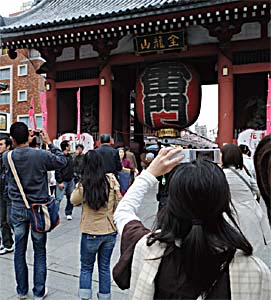 People taking photos with cell phone cameras in front of the Kaminarimon (“Thunder Gate”) at
Sensoji temple in Tokyo ->
People taking photos with cell phone cameras in front of the Kaminarimon (“Thunder Gate”) at
Sensoji temple in Tokyo ->© Hongo Jin
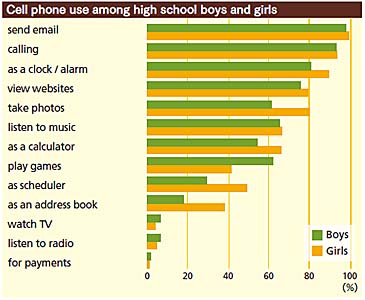
Source: “Research on Money in Children’s Lives” (2005). Central Council for Financial Services Information.
Purikura
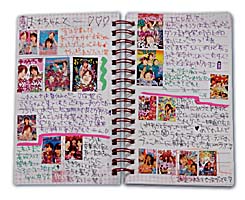 purikura techo |
Purikura, short for Purinto kurabu (Print Club),* is a photo booth where people can take their own photos, and a machine
then prints them out in few minutes automatically as stickers at a cost of 300 yen per set. After shooting, users can
decorate the frames or draw and write on the frames. This way, users can create imaginative and original stickers they can enjoy in various ways. Purikura has been popular among junior high school and senior high school girls ever since its 1995 debut in video arcades. Notebooks used to collect purikura pictures are called purikura techo (puricho for short), literally meaning “purikura notebooks,” and may have not just purikura pictures, but be dressed up with other kinds of stickers, drawings using colored pens or markers, and marginal comments. The fascination of purikura is not just taking pictures with friends and turning them into little artworks. Purikura sharing is a means of expressing friendship, and can also be used to record special times and moments. Purikura may be another factor that has made photography and albummaking much easier and more familiar. |
|
*Purinto-kurabu is technically a trademark, but products by other companies with the same feature are also commonly referred to as purikura. |
|
Take purikura with your friends!
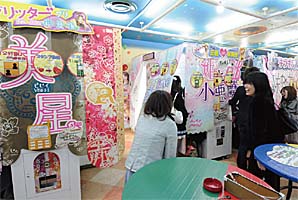 |
<-Purikura booths in video arcades. |
|
Touch the screen of the purikura and choose the background and frame for your stickers.-> |
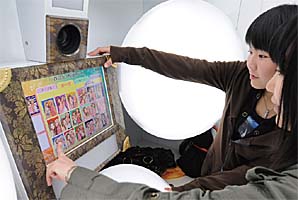 |
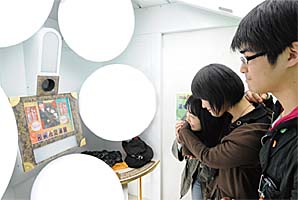 |
<-Pose in front of the professional lighting set up in front of the screen. |
|
After the photo is taken, you can draw on the image using a special pen connected to the purikura by a cord.-> |
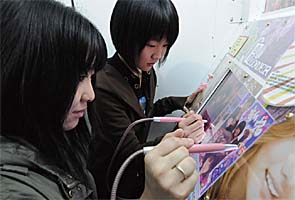 |
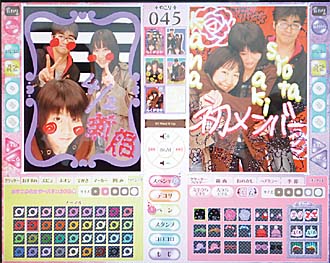 |
<-Screen after adding extras to the photo with the special pens: borders, exclamations, dates, messages or comments, about the friends posing together. |
|
The finished stickers come out of a slot in the machine in few minutes.-> |
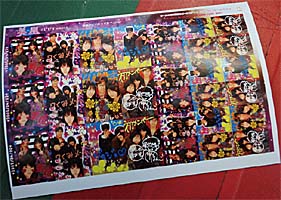 |
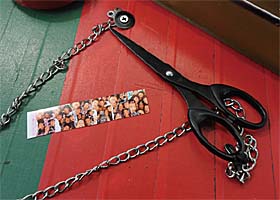 |
<-The booth provides scissors to cut and share the purikura stickers with friends. |

|
|
The World of Ume Kayo
|
With the proliferation of digital cameras and cameraequipped cell phones, more and more people are quick to take photographs whenever they find something interesting, amusing, or unusual in their daily lives. In Japan, where photography is a daily amusement of so many people, Ume Kayo, a young photographer, is currently gaining much attention. Ume Kayo, born in 1981, is the kind of photographer who can capture scenes we can all recall seeing (or must have seen) somewhere. Her photographs have a way of making you feel you are there yourself. They can bring forth all sorts of feelings and emotions—amusement, or nostalgia—or awaken precious personal memories. Her photographs radiate an energy and life that cannot be found in photographs taken by clever tricks or elaborate staging. Her first collection, entitled Ume-me, sold 110,000 copies (as of March 2008), a rare achievement for a photography collection, for which she received the 32nd Kimura Ihei Award* in 2007. Her other photo collection, titled Danshi, featuring elementary school boys living in her neighborhood, attracted widespread attention, selling 40,000 copies. She has received high praise in newspapers, magazines, on television shows and elsewhere, and her works have been highly rated in showings in Tokyo, Paris, London, and Bangkok. Ume’s photographs might show a mundane moment in everyday life that anyone might think they can photograph, but the secret of her success is that it is a moment no one can capture but her. |
|
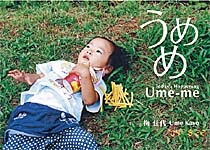 Ume-me published by Little More © UME KAYO |
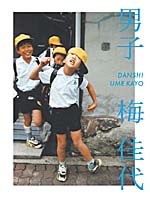 Danshi published by Little More © UME KAYO |
|
*Kimura Ihei Award |
|
High School Photography
While digital cameras have made taking photos easy for everyone, many high school students take photography seriously as part of their school club activities. There are roughly 5,500 high school photography clubs nationwide. Many members of these clubs still prefer traditional methods of photographing with film, which they develop themselves in the darkroom. They show their photographs at school culture festivals, enter works in photography contests held by the photography division of each prefecture’s senior high school cultural federation, and/or in monthly contests held by photography magazines.
“The Yomiuri Photo Grand Prix” http://www.yomiuri.co.jp/photogp/
The Yomiuri Photo Grand Prix is a contest held every year by the Yomiuri Shimbun Company, in which both professional
and amateur photographers from all over Japan are eligible. Awards are given in separate divisions for journalism (includes photos of crimes and accidents), special topics, high school, elementary and junior high school, and family.
The high school division is further separated into the “free” and “photo and essay” subsections. For the “free” subsection, the high school students’ task is to photograph school events, their school lives, and daily activities. For the “photo and essay” subsection, the photographer focuses on a single student, takes 5 or fewer pictures of him/her, and writes a short essay about the model and the photography process.
TJF’s “Lives of Japanese High School Students: Photo and Message Contest,” which ended in 2007, is carried on in this “Photo and Essay” subsection, to which TJF gives its full support. Some of the winning photographs will continue to be published for high school students overseas through the TJF website and publications.
Shashin Koshien [Photo Koshien]* http://town.higashikawa.hokkaido.jp/phototown/koshienofficial.htm
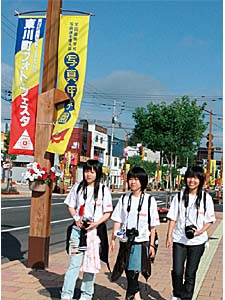
<-© Shashin Koshien 2007
Shashin Koshien, started in 1994, is a national photography contest for high school photography clubs all over Japan held in Higashikawa, a small town in Hokkaido with a population of less than 8,000. Higashikawa is hoping to revitalize the town through photography, not just with the Shashin Koshien but also through its international “Higashikawa Prize” for photography, the International Photography Festival, and its photo collection at the local Culture Gallery.
What is unique about Shashin Koshien is that contestants enter as teams instead of as individuals, only one work can be sent from one school, the topic and theme is open, and the work must be composed of 4 to 8 photographs. Over 200 schools throughout Japan submit entries. The primary competition is judged in 8 regional blocks by screening committees composed of photographers, magazine editors and others. Fourteen winners from the 8 blocks then compete at the main contest held in Higashikawa in July, in teams of three contestants and one coach.
For the main contest, each team uses the same kind of camera and photographs in the same area for 4 days. They select a specified number of photos according to their specified theme, and submit them as a collection. The collection is then judged in a public screening session, and the team with the highest score becomes the winner. Since many photographs must be taken in a limited time and organized into a single composition, teamwork is very important. Participants improve their skills as photographers and grow as individuals in the process of overcoming obstacles to achieve their goal.
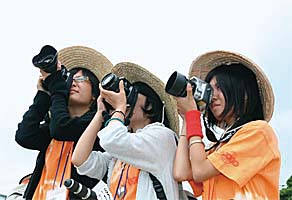 The main contest is also supported by local high school students, a staff of local citizens, and former contestants from previous contests. The Shashin Koshien offers a great opportunity to interact with and get to know a local community, not just the judges and participants from other schools.
The main contest is also supported by local high school students, a staff of local citizens, and former contestants from previous contests. The Shashin Koshien offers a great opportunity to interact with and get to know a local community, not just the judges and participants from other schools.
The main contest was once televised, and was also made into a comic. It is inspiring to see these students working with each other and reflecting on themselves via photography, thereby growing as individuals.
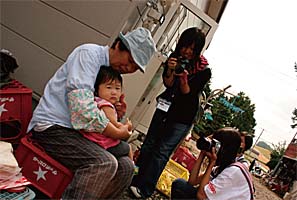 <-© Shashin Koshien 2007
<-© Shashin Koshien 2007
|
*“Koshien” |
Original text : Takarabako No.16 “Japanese Culture Now” June 2008.
Copyright(C)1997-2008 The Japan Forum. All rights reserved.
Send feedback to forum@tjf.or.jp